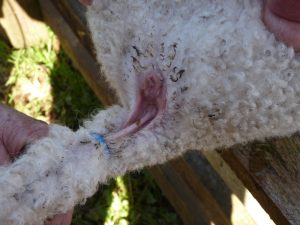FA youngstock processing
Tail docks
Tail docking is routinely done in lambs (to avoid painful fly strike), piglets (to avoid tail biting by other pigs) and less commonly in cattle (for cleanliness to cow, milk and producer). Tail docking may also be performed to treat tail trauma.
Cow tail docking is usually performed by the producer using castration rings. The tail is banded 7-8 cm below the vulva in calves, usually at the time of dehorning. Elective tail docking is now illegal in many states. There is no evidence that it improves cleanliness and there are concerns about pain, altered social communication and impact on fly control. When the tail is traumatized, tail docking can be performed surgically in a similar manner to small animal tail docks.
Sheep tail docking can be performed by rubber ring banding, banding combined with crushing (emasculatome), or hot blade. Most lambs are docked between 1-3 weeks of age. Local anesthesia does help and oral meloxicam would be reasonable. The AVMA has reviewed the practice and recommends:
“The Farm Animal Welfare Council (FAWC) recommends that docking should be avoided whenever possible.22 The FAWC also concluded that tail docking of lambs up to 7 days old is best done with a rubber ring; that lambs between the ages of 1 and 8 weeks old should be docked with a docking iron (hot blade) or a clamp; and that acute pain of tail docking can be alleviated using locally applied anesthetics.18 “
https://www.avma.org/KB/Resources/LiteratureReviews/Pages/Welfare-Implications-of-Tail-Docking-of-Lambs.aspx

If tails are docked too short, lambs are at increased risk of rectal prolapse. The tail should be long enough to maintain the full length of the caudal tail folds. These folds help move feces away from the perineal region. Other reasonable measures include 3 vertebrae and/or long enough to cover the vulva.
Pigs tend to bite each others tails. Once tail biting begins it continues and can even escalate. This can be minimized by shortening the tails. Tail docking is usually done by hot iron in pigs less than 7 days old. It is commonly combined with teeth clipping. The AVMA is reviewing this practice as well:
“Tail docking is performed to reduce tail biting and cannibalism among pigs. Tail docking should be performed early and sufficiently prior to weaning such that no open wounds remain at the time of weaning. Clean, sharp equipment must be used to minimize pain and risk of infection. “
https://www.avma.org/KB/Policies/Pages/Tail-Docking-and-Teeth-Clipping-of-Swine.aspx
Tail docking in piglets (when performed without any analgesia) has been shown to increase piglet pain, stress and fear of humans.
Resources
C Tallet et al. Evidence of Pain, Stress, and Fear of Humans During Tail Docking and the Next Four Weeks in Piglets (Sus scrofa domesticus). Front. Vet. Sci., 11 December 2019
P Aubry. Routine Surgical Procedures in Dairy Cattle Under Field Conditions: Abomasal Surgery, Dehorning, and Tail Docking. Vet Clin Food Anim 21 (2005) 55–72
C Stull. Welfare concerns: Tail docking of sheep. UCDavis- also goes through techniques
Li and Johnston UMN Extension –Research reaffirms the need for tail docking for pigs. 2016
E Dunthorne. Tail docking and castrating lambs: does the administration of local anaesthetic or meloxicam reduce the pain response exhibited? Veterinary Evidence, July 2021- reviews the literature

